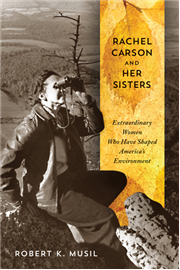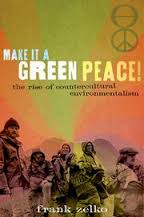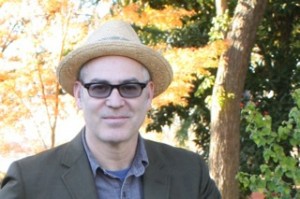Robert K. Musil. Rachel Carson and Her Sisters: Extraordinary Women Who Have Shaped America’s Environment. (New Brunswick: Rutgers University Press, 2014) 328 pages.
Frank S. Zelko. Make It a Green Peace!: The Rise of Countercultural Environmentalism. (New York: Oxford University Press, 2013) 400 pages.
Essay by Anthony Chaney
In her recent climate change bestseller, journalist Naomi Klein condemns three decades of inadequate response to industrial destruction of the environment for trying too hard to accommodate the reigning ethos of unregulated capitalism. With this in mind, it’s useful to revisit the earlier history of modern environmentalism. Two new books, Robert K. Musil’s Rachel Carson and her Sisters, Extraordinary Women Who Have Shaped America’s Environment (Rutgers, 2014) and Frank Zelko’s Make it a Greenpeace! The Rise of Counterculture Environmentalism (Harvard, 2014), narrate the contrasting approaches to ecology. They do so in ways that divide ecological thought along stereotypical understandings of gender. Musil’s cast of characters is a cooperative and mutually supportive set of women. Zelko’s are mostly combative and often reckless young men. It’s a minefield, treading the line between the found and the made in human nature.
Some historians might shy away from a title like Musil’s, which suggests raising up another neglected group deserving celebration. But Musil is not writing for scholars. The readers he has in mind he informs us, are those who “enjoy the outdoors and nature,” are birders or gardeners, or who belong “to a reading group or book club.” It’s a little off-putting to find in the first few pages the sentence, “I have written this book for readers like you,” and then suspect you’re not one of those readers (3). Not that there isn’t much to learn here. Musil teaches at American University and is the former long-time CEO for Physicians for Social Responsibility. He includes “plenty of endnotes and references for those of you in interdisciplinary classes,” who want “to seek out more books and information about the women you discover here.” It turns out the prose did spark my curiosity leading me to consult the endnotes. 
Musil show us how Rachel Carson did not emerge sui generis; she was not alone in her work, and others followed in her path. He places Carson in a contextual sisterhood of scientist-writer-activists whose work forged and continues to represent the environmental health arm of the broader environmentalist movement. The point is that this is a family, and Musil employs the language of family to reinforce it. Members include “foremothers” such as Ellen Swallow Richards, who introduced the term ‘ecology’ to Americans, and Mary Austin, the author of the 1903 nature classic, The Land of Little Rain. It includes contemporary sisters such as Mary Amdur, the “mother of air pollution toxicology,” and close colleagues of Carson’s, the activist Marjorie Spock and literary agent Marie Rodell, who helped Carson with the research for Silent Spring and to prepare for the expected backlash. It includes descendants such as the western writer and conservationist Terry Tempest Williams, the epidemiologist Devra Davis, and the biologist Sandra Steingraber. Some of these sisters lean toward nature writing and memoir, others toward nailing down the scientific data, and most blend the two as Carson did, but all have published books or taken part in activism that focuses on industrial toxins and their dangerous effects on human health. Musil’s book is thus a collection of summary biographies weaving in an annotated bibliography.
In terms of analysis, Musil identifies the DNA that makes these women kin. They have a “sense of wonder,” a “reverence for life,” an emotional connection to the living world (8). This both drives and confirms their devotion to science and research. They share “moral norms,” “a capacity for outrage,” and a determination to act (136). They employ, too, what Musil calls “imagination.” For Musil this speaks to method. Imagination is what these women used to bind scientific fact to moral judgment, and to pluck the strings of conscience in a lay readership. As writers, Carson and her sisters are not reluctant to frame their findings in narratives, to write lyrically, or to anthropomorphize nature and its creatures if that will get the point across. Many in Carson’s generation were raised on the moralistic literature of the “nature study movement,” birding books and articles from St. Nicholas magazine, material written by the foremothers, such Austin and Florence Merriam Bailey. This literature was part of a more general upbringing these women often shared: the liberal Protestantism of many nineteenth and early twentieth century progressives; homeschooling by educated mothers who might have become scientists or doctors in a more flexible cultural atmosphere. These mothers were comfortable in the out-of-doors, and passed their interest and ambition on to their daughters by encouraging them toward intellectual and professional achievement.
As Musil’s short bios build one upon another, the gender factor becomes clear without need for explicit argument. Part of the reason Carson and her sisters wrote for mainstream audiences was that academic positions in universities or other institutions were unavailable to them as women. They had to find other ways to pursue their ambitions, to make a living, or else to supplement their incomes from low-paying, low-status, unstable jobs in research. Writing for mainstream journals was one avenue, one that also answered to their moral goals. One might speculate that, whereas institutional structure and inherent gender bias put male scientists in positions to advance or defend the agenda of industrial capitalism, women, because of their outsider status, found their work directed toward illuminating the destructiveness and danger of that agenda. Unfortunately, Musil does not engage in that level of argument. He is content to champion these women as brave, persistent, empirically rigorous storytellers.
Musil’s group of patient, mild-mannered sisters working mostly behind the scenes makes for an unavoidable contrast to the testosterone-heavy style Frank Zelko explores in his history of Greenpeace. Zelko is a professor of environmental studies at the University of Vermont and a fellow at the Rachel Carson Center for Environment and Society at the Ludwig Maximilian University of Munich. Make it a Greenpeace! details the first decade of the organization’s founding in the 1970s: from its roots in non-violent Quaker anti-nuclear activism; its fast rise to prominence through novel, media-friendly forms of protest; through its establishment by the end of that decade into a decidedly more corporate — if still relatively radical – member of the large and well-funded international environmental groups  Naomi Klein refers to as “Big Green.” The Vancouver founding members were fortunate early in their choice of a name. Greenpeace memorably captured their merger of antiwar and environmental activism.
Naomi Klein refers to as “Big Green.” The Vancouver founding members were fortunate early in their choice of a name. Greenpeace memorably captured their merger of antiwar and environmental activism.
Nevertheless, if Musil depicts the Carson sisterhood as ever supportive, Zelko depicts Greenpeace’s struggle to define itself, despite its lucky name, as a factious and sometimes bitter series of power plays. One expects this in any history of an institution. More interesting is the struggle between competing visions. Perhaps the most prominent is the one the participants called “the Mystics versus the Mechanics” (93). The mechanics were the trained ecologists, wanting to convey a scientifically sound message respected by their peers. The mystics were the more committed counter-culturalists, who argued for consciousness change via holistic ecology as a secular religion. The dispute is a familiar one. Similar arguments divided many insurgent groups of that era. Another faction that didn’t quite fit into either group was the one engaged with the plight of animals. The move to recognize the pain and suffering of the higher mammals represented the egalitarian thrust in modern thought. By bringing whales into the individualist fold, this thinking was a kind of doubling down on humanism. The consciousness faction, led by the visionary underground columnist Robert Hunter, advocated something closer to a romantic post-humanism, which clouded the moral equation. This, Zelko writes, was the “thorny paradox” at the center of the group’s struggle over vision (94). On what basis could human predators be condemned if all creatures were merely parts in a vast interrelated ecology? At the same time, the granting of space inside what the environmental historian Roderick Frazier Nash called “the circle of ethical relevancy” did not necessarily hinge on scientific data provided by ecologists.
Yet it is in the egalitarian, rights-based tradition that Zelko argues for Greenpeace’s historical significance. Abolitionists used their bodies to block the capture of runaway slaves. Civil rights activists blocked businesses-as-usual by standing on sidewalks and sitting at lunch counters. Both created media-friendly spectacles meant to raise public consciousness. Similarly, Greenpeace activists placed their bodies between whales and harpooners, filmed themselves doing it, and for a time at least, the media ate up the footage. Greenpeace has been criticized for tainting environmentalist protest in its beginnings with a “macho, confrontational style” (319). Zelko thinks this goes too far. The “visceral experience” of the group’s tactical model, “and the passion it summoned forth, was something new in the environmental movement,” he argues (255). “Whatever its shortcomings,” Zelko sums up, “Greenpeace created a new and potent method” for standing up to the powers’ reckless abuse of the environment (322). Zelko does not point this out, but the method precedes that of today’s “Blockadia,” the international movement of bodily resistance to the extractive industries that Klein describes.
The factionalism related by Zelko, in comparison to Musil’s warmer and fuzzier stories, may boil down to the fact that Zelko, in rising to an academic standard, is more ambitious in his research. While Musil offers useful information, his sources are almost entirely secondary, pulled from existing biographies. His coverage of the books of the more contemporary writers – Tempest Williams and Davis, for example – are celebratory and uncritical. Zelko, in contrast, makes use of extensive interviews of many of his story’s major players, as well as their memoirs, and official papers. The material is rich and provides a great deal of texture. In its first few anti-whaling campaigns, conducted in beat-up fishing boats and zippy, outboard inflatables, the group comes up against governments and corporations in the form of navy vessels and giant factory ships. These passages are dramatic and absorbing. Zelko’s deep reading in the various strands of modern environmental thought not only alerts the reader to the relevant canon, but allows a critical examination of how conflict between ideas played out in concrete events. In the chapter on the group’s first foray into anti-sealing, Zelko places each interested party in its context, from the baby harp seals (“whitecoats”), to the poor, hardy Newfoundland “swilers” who hunted them and who were themselves preyed upon by higher-ups on the capitalist food chain. This is environmental history as social history, and it makes for fine reading.
Both Zelko and Musil come up against an enduring incoherence between the moral and the scientific. Musil praises the Carson method of combining hard data with “poetic sensibility” and a “fundamental love of nature” (5, 256). He doesn’t examine however the lack of authority love and poetic sensibility have where decisions about industrial activity are made, or why Carson’s combination of “the sciences and the humanities” would evoke from her opponents charges of softness and sentimentality – characteristics associated with the feminine. We know where Musil stands. He stands with Carson and her sisters against the refusal of industries, industry-friendly politicians, and the scientists on their payrolls to “incorporate values” with hard data (14).
Where Zelko stands is harder to ascertain. One suspects he sympathizes with Robert Hunter, the self-proclaimed “flipped-out mystic” whose hope was that an ecological consciousness would lead toward a more coherent integration of facts with values (234). One suspects he is less sympathetic with David McTaggart, the former player in Los Angeles real estate who wrested control from Greenpeace’s mystical faction and succeeded finally in giving the organization a lasting voice. This charge is mere speculation. Zelko is careful to maintain a “critical habit of mind,” in Christopher Lasch’s phrase. To do otherwise might be too sentimental.

Anthony Chaney (PhD, University of Texas at Dallas) is working on a book about Gregory Bateson, his double bind concept, and its connection to ecological thought.

0